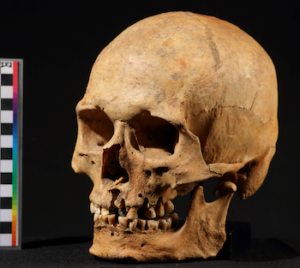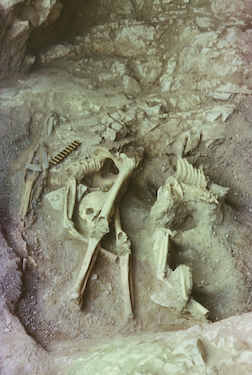
CELL PRESS—The movement of people across the Bering Sea from North Asia to North America is a well-known phenomenon in early human history. Nevertheless, the genetic makeup of the people who lived in North Asia during this time has remained mysterious due to a limited number of ancient genomes analyzed from this region. Now, researchers reporting* in Current Biology on January 12 describe genomes from ten individuals up to 7,500 years old that help to fill the gap and show geneflow from people moving in the opposite direction from North America to North Asia.
Their analysis reveals a previously undescribed group of early Holocene Siberian people that lived in the Neolithic Altai-Sayan region, near to where Russia, China, Mongolia, and Kazakhstan come together. The genetic data show they were descendants of both paleo-Siberian and Ancient North Eurasian (ANE) people.
“We describe a previously unknown hunter-gatherer population in the Altai as early as 7,500 years old, which is a mixture between two distinct groups that lived in Siberia during the last Ice Age,” says Cosimo Posth at the University of Tübingen, Germany, and senior author of the study. “The Altai hunter-gatherer group contributed to many contemporaneous and subsequent populations across North Asia, showing how great the mobility of those foraging communities was.”
Posth notes that the Altai region is known in the media as the location where a new archaic hominin group, the Denisovans, was discovered. But the region also has importance in human history as a crossroad for population movements between northern Siberia, Central Asia, and East Asia over millennia.
Posth and colleagues report that the unique gene pool they uncovered may represent an optimal source for the inferred ANE-related population that contributed to Bronze Age groups from North and Inner Asia, such as Lake Baikal hunter-gatherers, Okunevo-associated pastoralists, and Tarim Basin mummies. They uncovered Ancient Northeast Asian (ANA) ancestry as well—which had initially been described in Neolithic hunter-gatherers from the Russian Far East—in another Neolithic Altai-Sayan individual associated with distinct cultural features.
The findings reveal the spread of ANA ancestry about 1,500 kilometers farther to the west than previously observed. In the Russian Far East, they also identified 7,000-year-old individuals with Jomon-associated ancestry, indicating links with hunter-gatherer groups from the Japanese Archipelago.
The data also are consistent with multiple phases of gene flow from North America to northeastern Asia over the last 5,000 years, reaching the Kamchatka Peninsula and central Siberia. The researchers note that the findings highlight a largely interconnected population throughout North Asia from the early Holocene onwards.
“The finding that surprised me the most is from an individual dated to a similar period as the other Altai hunter-gatherers but with a completely different genetic profile, showing genetic affinities to populations located in the Russian Far East,” says Ke Wang at Fudan University, China, and lead author of the study. “Interestingly, the Nizhnetytkesken individual was found in a cave containing rich burial goods with a religious costume and objects interpreted as possible representation of shamanism.”
Wang says the finding implies that individuals with very different profiles and backgrounds were living in the same region around the same time.
“It is not clear if the Nizhnetytkesken individual came from far away or the population from which he derived was located close by,” she says. “However, his grave goods appear different than other local archeological contexts implying mobility of both culturally and genetically diverse individuals into the Altai region.”
The genetic data from the Altai show that North Asia harbored highly connected groups as early as 10,000 years ago, across long geographic distances. “This suggests that human migrations and admixtures were the norm and not the exception also for ancient hunter-gatherer societies,” Posth says.
_____________________________

Skull Sergey V. Semenov
______________________

Photo of grave. Nadezhda F. Stepanova
______________________
Article Source: Cell Press news release
This work is supported by the Max Planck Society, Alon Fellowship, Russian Science Foundation, Russian Foundation for Basic Research, National Research Foundation of Korea (NRF), Ministry of Science and Higher Education of the Russian Federation, and Altai State University.
*Current Biology, Wang et al.: “Middle Holocene Siberian genomes reveal highly connected gene pools throughout North Asia” https://www.cell.com/current-biology/fulltext/S0960-9822(22)01892-9
Current Biology (@CurrentBiology), published by Cell Press, is a bimonthly journal that features papers across all areas of biology. Current Biology strives to foster communication across fields of biology, both by publishing important findings of general interest and through highly accessible front matter for non-specialists. Visit http://www.cell.com/current-biology. To receive Cell Press media alerts, contact press@cell.com.
______________________
Advertisement

Don’t miss out on this unforgettable evening as Dr. Hawass reveals the most closely guarded secrets of ancient Egypt and presents his groundbreaking new discoveries and latest research live on stage. As the man behind all major discoveries in Egypt over the last few decades and director of several ongoing archaeological projects, Dr. Hawass may yet surprise you with unexpected revelations that will make news across the world.
______________________
Advertisement





